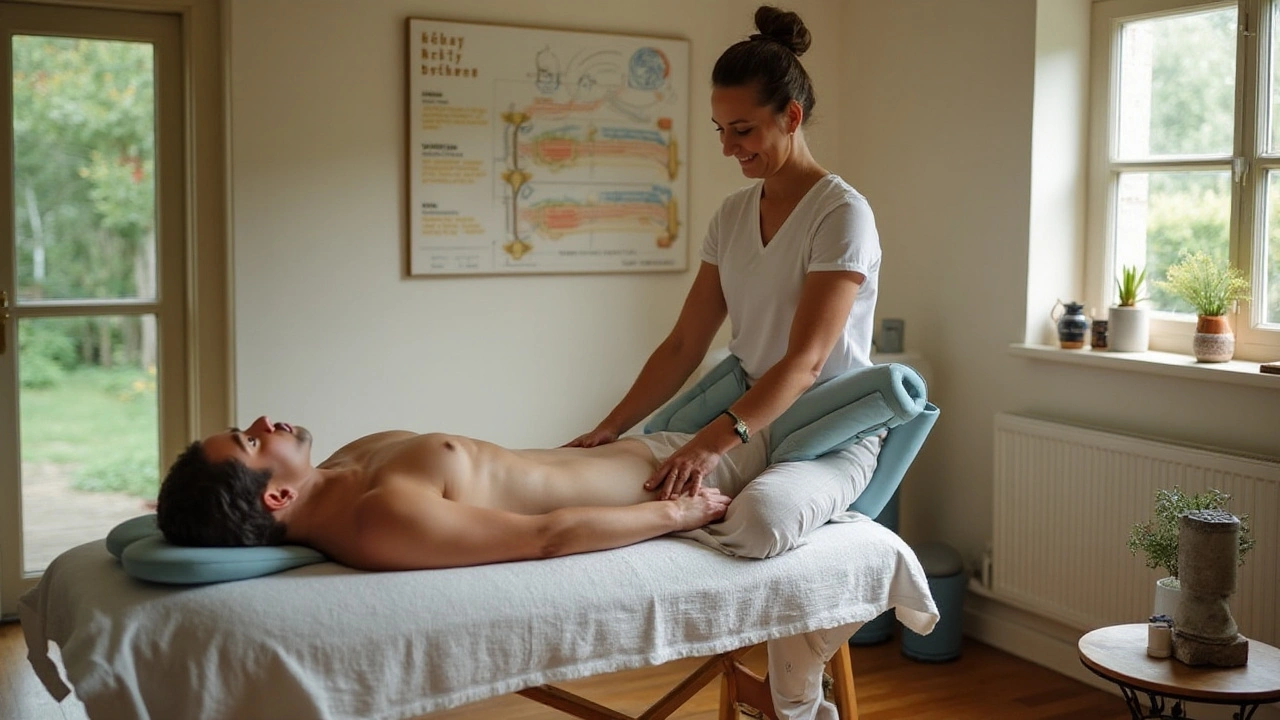Unlocking the Healing Power of Myofascial Release Therapy

- Aug, 20 2024
- 0 Comments
- Melinda Underwood
Imagine a therapy that targets the root of your muscle pain and offers lasting relief. Myofascial Release Therapy does just that by focusing on the fascia, a web-like structure of connective tissue that supports and surrounds muscles and organs.
In this article, we’ll dive into what Myofascial Release Therapy is, how it works, and why so many people are turning to it for pain reduction and improved mobility. From professional techniques to self-care tips you can try at home, discover how this holistic approach can enhance your overall well-being.
- Understanding Myofascial Release
- How It Works
- Health Benefits
- Techniques and Tools
- Finding a Professional Therapist
- Self-Myofascial Release: Tips and Tricks
Understanding Myofascial Release
Myofascial Release Therapy is a fascinating and effective technique that has been growing in popularity among those seeking relief from chronic pain and improved physical function. At its core, this therapy focuses on the fascia, a thin, tough connective tissue that wraps around every muscle, bone, nerve, and organ in the body. When the fascia is healthy, it’s flexible and pliable. But when it becomes inflamed or damaged, it can constrict and cause significant pain and discomfort.
The term ‘myofascial’ combines ‘myo,’ meaning muscle, and ‘fascia,’ referring to this all-important connective tissue. Understanding this relationship is crucial because when fascia tightens, it can lead to a domino effect on the surrounding muscles and other parts of the body. This interconnectedness is why pain in one area might be felt in another, seemingly unrelated place.
Traditional massage focuses on muscles themselves, but Myofascial Release goes deeper. The goal is to stretch and release these tight fascia, thereby relieving tension and promoting better movement and circulation. It’s like giving your body a spring clean, freeing up those internal cobwebs that have been causing restrictions and pain.
According to Dr. John F. Barnes, a leading expert in Myofascial Release Therapy, ‘By releasing the fascia, we can often relieve pain and restore function that other types of therapy haven’t been able to address.’
This therapy can address a broad range of issues, from chronic headaches to plantar fasciitis. It’s also used as a complementary treatment for those recovering from surgeries or injuries. Specially trained therapists use techniques involving gentle sustained pressure and stretching to ensure the fascia releases properly. Sometimes, they also use tools like foam rollers or specialized massage balls to target specific areas.
Many people first become aware of Myofascial Release after experiencing unexplained pain and stiffness. Often, traditional treatments or pain medications don’t provide lasting relief because they neglect the underlying fascial restrictions. By targeting and treating these restrictions directly, Myofascial Release offers a holistic approach that can lead to long-term healing.
Historical Background
The concept of myofascial release isn’t new; it traces back to osteopathic medicine and the work of early pioneers like Dr. Andrew Taylor Still. But its formalization as a specific therapy can be credited to practitioners like Dr. John Upledger and Dr. Barnes. Their research and practical applications have brought this therapy into mainstream awareness over the last few decades.
This method isn't merely about ‘rubbing out the knots.’ It requires a deeper understanding of the body’s structure and the way fascia operates under different conditions. Fascial restrictions can be caused by trauma, inflammation, surgical procedures, and even stress. The therapy’s effectiveness lies in its ability to break down these restrictions, which can help the body return to a more balanced and pain-free state.
An interesting fact about fascia is its resistance to traditional stretching. You can’t simply stretch it out like a muscle with quick, forceful movements. Instead, Myofascial Release employs slow, sustained pressure that allows the fascia to unwind and lengthen naturally. This is why sessions can sometimes be an hour long or more, focusing on different parts of the body in a systematic way.
Scientific Support
The benefits of Myofascial Release have been backed by various studies. For instance, a study published in the Journal of Bodywork and Movement Therapies found that patients undergoing Myofascial Release reported significant reduction in pain and improvement in function after just a few sessions. These findings are helping to cement Myofascial Release as a scientifically credible therapy that deserves its place alongside more conventional treatments.
So, if you’re grappling with unexplained aches and pains or if conventional therapies haven’t provided the relief you hoped for, Myofascial Release Therapy might be worth exploring. With its holistic focus on the fascia and its connection to our overall physical health, it offers an intriguing and often effective alternative for those seeking a path to wellness.
How It Works
Myofascial Release Therapy is an innovative approach aimed at reducing pain and restoring movement by targeting the body’s fascial system. Fascia is a thin, tough layer of connective tissue that surrounds every muscle, bone, nerve, and organ in your body. Over time, due to injury, inflammation, or even poor posture, these fascial tissues can become tight and restricted. These restrictions cause discomfort and limit your mobility.
The primary goal of Myofascial Release is to ease the tension within this fascial network. Therapists use their hands to locate areas of tightness and apply gentle, sustained pressure. This technique differs from a traditional massage because it targets the fascia rather than the muscles themselves. The therapist may hold pressure on a knot for several minutes until the tissue softens and elongates. It is this gentle, sustained pressure that helps to 'release' the fascia.
During a session, you may feel slight discomfort in the beginning as the fascia begins to release. However, this typically transitions into a feeling of relief and relaxation. The therapist may also use tools such as foam rollers or specialized balls to aid in loosening these tight areas. The difference Myofascial Release offers compared to other therapies lies in its ability to treat the entire fascial system, which can be interconnected throughout the body.
John F. Barnes, a pioneer in the field of Myofascial Release, once said, "Find the pain, look elsewhere for the cause." This highlights the interconnected nature of the fascia, where tension in one area can trigger pain in another.
Also, Myofascial Release Therapy can be effectively paired with other treatments for enhanced results. Whether you’re dealing with chronic pain, recovering from an injury, or just looking to improve your flexibility, understanding how this therapy works can be the first step towards a healthier and pain-free life.
| Myofascial Release Techniques | Description |
|---|---|
| Direct Release | Applying direct, sustained pressure on the restricted area until the tissue releases. |
| Indirect Release | Gently moving the tissue in the direction it naturally wants to go to encourage a release. |
Myofascial Release is not just about the therapy itself; it’s also about understanding the role of fascia. This awareness can influence how we move, sit, and generally engage with our bodies. Including this therapy in your wellness routine can provide significant, lasting benefits for both physical and mental well-being.

Health Benefits
Myofascial Release Therapy offers numerous health benefits that extend beyond simple pain relief. First and foremost, it is known for effectively relieving chronic pain. By focusing on the fascia, this therapy addresses tension and knots that are often missed by traditional massages. Whether it’s back pain, shoulder pain, or plantar fasciitis, people report significant improvement in their symptoms.
Another major benefit is improved mobility. When the fascia is tight, it restricts movement. Releasing this tension can help you move more freely and with less discomfort. Athletes and fitness enthusiasts particularly find myofascial release invaluable because it helps them recover faster and maintain flexibility, which reduces the likelihood of injuries.
Additionally, myofascial release has been linked to better circulation. When fascia is tight, it can impede blood flow. This therapy helps to ensure that blood and lymphatic fluids move more efficiently throughout the body. Better circulation means more oxygen and nutrients are delivered to muscles and organs, which can promote healing and reduce inflammation.
Mental health also gets a boost from this kind of therapy. By relieving physical tension, many people experience reduced stress and anxiety. The therapy sessions often include elements of mindfulness and deep breathing, adding a holistic layer that benefits both body and mind.
Holistic healing is another key term associated with myofascial release. It emphasizes treating the body as an interconnected system, rather than isolated parts. This approach is particularly beneficial for those suffering from conditions like fibromyalgia or tension headaches, where traditional treatments offer limited relief.
The therapy also aids in postural corrections. Poor posture can result from tight fascia pulling the body out of alignment. Over time, regular sessions can help align the body properly, reducing the risk of future musculoskeletal issues. People who spend a lot of their day sitting, especially in front of a computer, often find this benefit particularly worthwhile.
According to Dr. John F. Barnes, a pioneer in the field, "Myofascial release is to the human body what a tune-up is to a vehicle. It keeps all the parts running smoothly."
Finally, it’s worth mentioning the emotional release some individuals experience. Fascia holds emotional memories and past traumas. Sometimes, releasing physical tension can also lead to an emotional catharsis, something many find surprising but deeply therapeutic.
The growing popularity of myofascial release therapy is no surprise considering its wide range of benefits. From immediate physical relief to long-term holistic wellness, it’s a versatile therapy that can fit into anyone’s healthcare regimen.
Techniques and Tools
Myofascial Release Therapy encompasses a variety of techniques and tools designed to target and release the tightness and pain in the fascia. At the heart of these methods is the aim to provide relief and improve range of motion in the affected areas. One common technique used by therapists involves applying gentle, sustained pressure to the myofascial connective tissue restrictions. This is usually done with their hands, gradually increasing the pressure to stretch and loosen the fascia.
A popular tool in Myofascial Release Therapy is the foam roller. Foam rolling has become a staple for many athletes and fitness enthusiasts due to its effectiveness in reducing muscle soreness and improving flexibility. It is user-friendly and can be easily incorporated into a daily routine. By rolling different parts of your body over the foam roller, you can target and release tension in specific areas.
Another essential tool in this therapy is the lacrosse ball. Because of its small size and firmness, it can reach deeper layers of muscle and fascia that a foam roller might miss. It's particularly useful for targeting knots in tricky spots like the shoulders and upper back. Simply placing the ball between your body and a hard surface, like a wall or floor, and applying pressure can help break up the tightness.
Tools such as massage sticks and TheraCanes are also used to apply pinpoint pressure to specific areas. Massage sticks allow for rolling out muscles similar to foam rollers but with the convenience of using your hands to reach various angles. TheraCanes, on the other hand, are designed to provide leverage, allowing users to massage hard-to-reach muscles efficiently.
It’s essential to mention the importance of breathwork during myofascial release. Deep breathing can enhance the release process, encouraging relaxation and a deeper stretch. As you work on releasing tension, make sure to take slow, deep breaths to aid the process.
Electromyography (EMG) machines are occasionally used by professional therapists to measure muscle electrical activity. These machines can help identify areas of extreme muscle tension, providing a targeted approach to therapy.
According to Dr. John F. Barnes, a pioneer in Myofascial Release Therapy, 'The key is sustained pressure over time, allowing the fascia to lengthen and reform.'
Whether you're working with a professional therapist or using these tools at home, consistency is crucial. Regular sessions can lead to significant improvements in mobility and pain relief. A balanced approach, combining professional treatments with self-care techniques, is often the most effective way to manage chronic pain and enhance overall well-being.

Finding a Professional Therapist
When it comes to embracing the benefits of myofascial release, finding the right therapist is crucial. A professional therapist who specializes in myofascial release can offer personalized treatment plans tailored to your specific needs. The journey to finding such a therapist may seem daunting, but it’s actually more straightforward than you think.
Start by researching certified therapists in your local area. Look for certifications from reputable organizations such as the International Myofascial Release Therapy Academy. Browse through their qualifications, experience, and reviews from previous clients. Websites like Healthgrades and even social media platforms can provide useful insights and reviews. It’s important to choose a therapist with ample experience and positive feedback.
Don’t hesitate to ask questions before scheduling your first appointment. Good therapists are transparent about their methods, experience, and what to expect from the sessions. Inquire about their approach to myofascial release therapy and whether they combine it with other techniques, like massage or physical therapy. Understanding their approach will help you feel more comfortable and confident in their care.
An initial consultation can provide a sense of the therapist’s skill and your comfort with them. During this meeting, the therapist will typically conduct a thorough assessment of your medical history, current physical condition, and specific issues you aim to address. This is also the time to ask about the frequency of sessions and any at-home exercises you might need to perform.
It’s essential to consider the cultural fit as well. Everyone has different expectations and comfort levels during therapy. Trust and mutual understanding between you and your therapist enhance the effectiveness of the treatment. Feel free to switch therapists if you feel they do not meet your expectations. Your comfort and treatment’s success are the top priorities.
Therapy benefits can be significantly amplified when you work with a knowledgeable and empathetic therapist. These professionals not only guide you through the physical aspects of myofascial release but also support you emotionally, helping you stay motivated and informed throughout your healing journey. Seek out therapists known for their holistic approach.
“Finding the right therapist is like finding the right piece to a puzzle. It’s about compatibility, comfort, and trust.” - Dr. Alex Fraser, Holistic Health Specialist
Lastly, don’t forget to check the logistical aspects such as the location of the clinic, session costs, and availability. Make sure their operation hours align with your schedule. Some therapists may also offer packages that reduce the overall cost of treatment. Insurance coverage may vary, so check with both your insurance provider and the therapist.
Self-Myofascial Release: Tips and Tricks
Self-myofascial release (SMR) is a technique that can be done at home to help release tension and tightness in the fascia. It’s a convenient way to experience some of the benefits of myofascial release therapy without needing a professional therapist. The key to SMR is consistency and using the right tools.
A popular tool for SMR is the foam roller. Foam rolling is effective for targeting larger muscle groups like the thighs, back, and calves. To use a foam roller, you gently roll the targeted muscle area over the foam roller, applying moderate pressure. It’s essential to move slowly and pause on any tight spots or trigger points, holding for several seconds to let the tissue release.
Other tools include massage balls and sticks. Massage balls are particularly useful for smaller or hard-to-reach areas like the shoulders and feet. By placing the ball against the muscle and using your body weight, you can work out knots and tension. Massage sticks, on the other hand, are excellent for areas like the arms and neck because they offer more control with pressure.
Consistency is crucial when it comes to SMR. Aim to dedicate at least ten to fifteen minutes per day to your practice. This regularity can lead to decreased muscle soreness, improved flexibility, and better overall muscle function. It’s beneficial to incorporate SMR into your daily routine, either before or after exercise, or even during your evening wind-down.
“Regular practice of self-myofascial release can significantly improve muscle performance and decrease pain,” says Dr. Sandra Kim, a renowned physical therapist.
“It’s an accessible method for many people looking to manage their muscle health independently. Just ensure you’re using the correct technique to avoid injury.”
When engaging in SMR, it’s important to listen to your body. Applying too much pressure or rolling too quickly can cause bruising or injury. Start gently and increase intensity as needed. If you have medical conditions or injuries, consult with a healthcare provider before starting SMR.
Here are some tips for a successful SMR session:
- Always warm up your muscles with light activity before beginning SMR.
- Focus on your breathing to help relax your muscles during the session.
- Don’t rush through the movements; slow and controlled is key.
- Hydrate well as water helps keep the fascia pliable and healthy.
- Combine SMR with regular stretching for better results.
- Use the appropriate tool for each muscle group for maximum efficiency.
By incorporating these tips into your routine, you can maximize the therapeutic effects of self-myofascial release and keep your muscles in top shape. So, grab your foam roller or massage ball and start discovering the benefits of this at-home therapy.